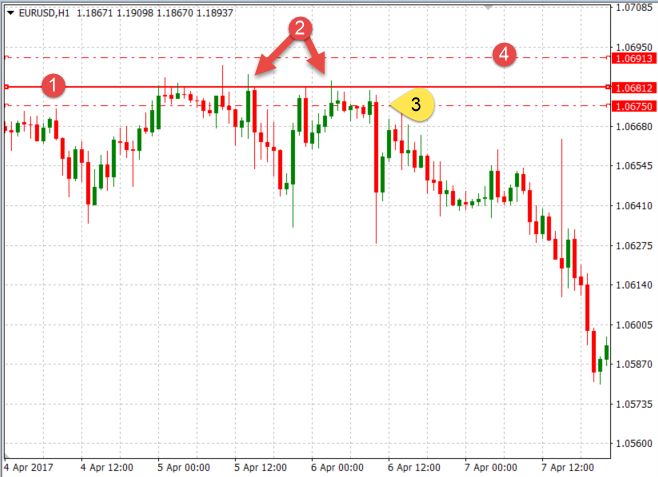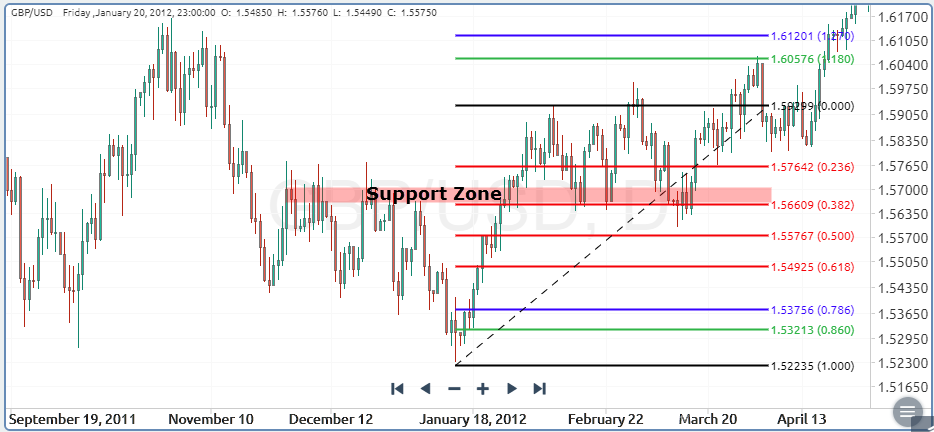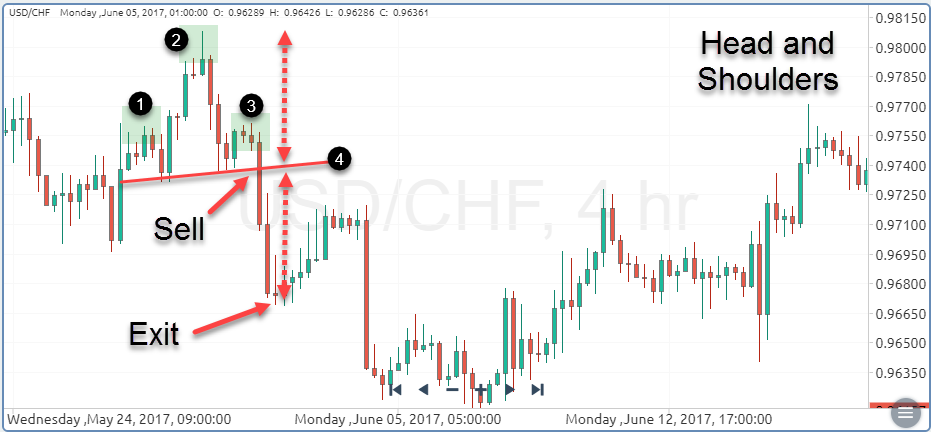The stop and profit targets of your trades play a crucial role in your trading success. Many traders, especially those who are just getting started with trading, place their exit targets at arbitrary levels.
Unfortunately, this approach can limit your trading performance significantly. Placing your exit orders too tight or too wide from the entry price can increase your losses and lower your potential profits.
To help you with defining the best levels for placing your exit orders, I’ve prepared this article that covers many important concepts around stop and profit targets, including the reward-to-risk ratio of trades, different types of stop orders, position sizing and more.
The Importance of Exit Targets
The quality of your analysis is not the only determining factor of your trading success. Even with a well-defined and robust trading strategy, your bottom line can still be shrinking if you’re arbitrary placing your stop-loss and take-profit levels.
Stop-loss and take-profit levels also play an important part in your risk management. If you place your profit targets too far away from the entry price, chances are that your target won’t be reached and that the price will reverse and hit your stop level. Similarly, if you place your profit target too close to your entry price, you may not be able to get the most out of your trade setup.
The situation with stop-losses is quite similar. Place your stop too far away, and you’ll risk a larger loss if the trade goes against your favor. Place it too close, and you’ll likely get stopped out on simple market noise and regular price fluctuations.
That’s why defining your trade’s stop and profit target plays a crucial role in your trading performance. Identifying a high-probability trade setup is just one side of the coin. If you don’t know where to exit your trade, your trading will suffer.
Reward-to-Risk Ratio
The reward-to-risk ratio is determined by the relation between the sizes of your stop and profit targets.
For example, if your trade has a stop-loss that is 50 pips away from the entry price and a profit target that is 100 pips away from your entry price, that trade’s reward-to-risk ratio would equal to 2:1. This means that your potential profit is two times higher than your potential loss.
A trade with a reward-to-risk ratio of 1:1 means that both the stop-loss and take profit levels are equally far away from the entry price.

Chart: The concept of reward-to-risk
A survey conducted by a large Forex broker showed that traders who adopt a reward-to-risk ratio of at least 1 are more successful than traders who use lower R/R ratios.
A trader who only takes trades with R/R ratios of 1 needs a 50% winning rate to breakeven. On the other hand, R/R ratios lower than 1 require a proportionally higher winning rate, because losses on losing trades exceed profits on winning trades.
Always look for trading opportunities that carry reward-to-risk ratios of 1 or higher. The sweet spot for most trading strategies is an R/R ratio of 2:1, i.e. the profit target should be twice the size of your stop-loss.
Types of Stops
Before we dig deeper into the most effective ways of defining your stop and profit targets, let’s quickly cover the main types of stops. While each type has its advantages and disadvantages, I strongly encourage you to use chart stops in your trading.
- Time stops
For example, if a trader can decide to close a trade after the New York session, the current trading day, or the current trading week has ended. Time stops are quite popular among day traders who don’t want to hold their positions open overnight. - Equity stops
While risking a small amount of your trading account is one of the most important rules in risk management, your stop-loss size should not be based on equity stops! We’ll show you how to risk a pre-defined percentage of your trading account with position sizing later in this article. - Chart stops
Many successful traders use chart stops and place their stop-losses a few pips above an important resistance level or a few pips below an important support level. - Volatility stops
For example, if the EUR/USD showed an average 4-hour volatility of 30 pips over the last week, a volatility stop could be placed at twice the length of the pair’s average volatility. A popular technical indicator for volatility stops is the Average True Range indicator.
How to Identify Stop Targets
The best way to define your stop-loss targets is to use chart stops. Unlike the other types of stops, chart stops are based on important technical levels and provide an additional layer of security in trading.
Support and resistance levels
Support and resistance levels are usually the most obvious levels for placing stops. In trading, support refers to a level where the price has difficulties breaking below, while resistance refers to a level where the price has difficulties breaking above.
Support and resistance levels often form around recent swing highs and lows, but can also come in the form of trendlines, channels and round-number psychological levels.
Many high-probability trade setups are based on these technical levels, so make sure to learn them in and out if you want to become a successful trader. You can also check out the trading course at My Trading Skills, which is hosted by professional traders and covers all you need to know to succeed in the markets.
When placing a stop based on a support level, take a look at the daily chart as support levels on longer-term timeframes have more importance than short-term support levels.
In addition, never place your stop directly at a support level, or you risk getting stopped out only for the price to reverse immediately after (sounds familiar?). Instead, place your stop a few pips below the support level, which ensures that you’ll get stopped out only if the price breaks the support.
The same rules apply for placing stops based on resistance levels. First, identify longer-term resistance levels and always place your stop a few pips above a resistance.

Chart: Line no. 4 shows a stop-loss order placed above a resistance level (1). Point (2) shows the inability of the price of the break above the resistance level.
If you’re trading based on trendlines and channels, a good way to place your stops is just above a falling trendline and just below a rising trendline. The same applies for channels – place your stops a few pips below a rising channel when going long and a few pips above a falling channel when going short.
Fibonacci levels
Fibonacci levels are a popular tool to measure the distance of price corrections during strong trends relative to a previous impulse move.
Popular Fibonacci levels include the 38.2% level, the 50% level and the 61.8% level which are closely watched by many market participants. If the price reaches and shows to respect one of these levels, you could enter into a trade in the direction of the overall trend with a relatively low risk and a high reward-to-risk ratio.
Simply place your stop a few pips below the respected Fibonacci level in case of a long position, and a few pips above the respected Fibonacci level in case of a short position.
The following chart shows a potential price-level for a stop-loss order, placed just above the 78.6% Fib level.
 Chart: Placing a stop-loss above a Fibonacci retracement during downtrends
Chart: Placing a stop-loss above a Fibonacci retracement during downtrends
Average True Range (ATR) indicator
Developed by J. Welles Wilder, the Average True Range (ATR) indicator is a volatility indicator that measures the degree of recent price volatility. The indicator’s value is based on an N-period smoothed moving average of the true range values which take into account the previous highs, lows, and closing prices.
A popular way to use the ATR indicator is to place stop-loss levels at twice the current ATR value. This ensures that your stop-loss won’t be hit by regular market noise.
Some traders combine the ATR indicator with support and resistance levels and avoid placing their stops at S/R levels that are inside twice the current ATR value.
Trailing Stops
Last but not least, trailing stops offer an effective way to lock in parts of your profits as a trade goes in your favor. Trailing stops trail the current price.
When your trade goes 1 pip up, a trailing stop automatically follows and moves your stop-loss for 1 pip. However, if the price goes 1 pip against you, a trailing stop will stay at its current level.
Trailing stops allow you to ride a trend as long as it lasts and to lock in profits as your trade is reaching your profit target. The best results are achieved when using trailing stops during strong trends.
Position Sizing: Your Stop Size Determines Your Position Size
You’ve probably heard about the 2% rule, which says that the maximum amount you should risk on any single trade is 2% of your trading account size.
If you use a chart stop that is based on technical levels, the only way that you can control your risk is with the size of your position. Technical levels determine the size of your stop-loss and the size of your position determines the maximum amount that you can potentially lose if your stop loss gets hit.
There are three simple steps to determine the position size you should trade.
Step 1: Calculate your total risk
The total risk of your trade shouldn’t be larger than 2% of your trading account. For example, if your trading capital is $10.000, then you shouldn’t risk more than $200 on any single trade.
Step 2: Identify your chart stop
Let’s say you’ve identified a rising channel in the GBP/USD pair and the price has bounced off the lower channel support. You’ve decided to place your stop-loss a few pips below the lower channel line, which is around 40 pips away from the entry price.
Step 3: Calculate your position size
In the last step, you need to calculate your position size based on your stop size and desired risk per trade. In order to risk $200 with a 40 pips stop-loss, each pip should be roughly worth $5 ($200 / 40 pips).
Many trading platforms allow you to set your position size per pip-value, but as a rule of thumb, one standard lot (100.000 units of the base currency) has a pip-value of around $10.
How to Set Profit Targets
Defining your trade’s profit target is as important as placing your stop-loss at the right level. While your stop-loss protects your trading capital when the market goes against you, your profit targets ensure that you make a profit and grow your bottom line.
Placing your profit targets too far away from your entry price carries the risk that the market will reverse and hit your stop-loss. Place them too tight, you’ll miss on a large portion of potential profits.
Here’s how to set your profit targets at the right level.
Support and resistance levels
Just like in the case of stop-loss levels, support and resistance can be used for placing profit targets. Try to identify important support and resistance levels on your chart and place your profit targets accordingly.
In a short position, place your take profit a few pips above a support level, and in a long position, aim for a few pips below a resistance level.
Be realistic with your profit targets. The Average True Range indicator can help you measure the degree of price volatility in a currency pair. If you’re trading on the 1-hour chart, it doesn’t make much sense to place your profit target at twice the pair’s average weekly volatility.
Fibonacci extension levels
Fibonacci extension levels, also known as Fibonacci expansions and Fibonacci projections, are levels based on the Fibonacci sequence of numbers that go beyond the 100% Fibonacci retracement level. Many popular trading platforms allow you to draw Fibonacci extension levels together with retracement levels.
Important extension levels that act as hidden support and resistance level in the chart are the 123.6%, 127%, 138.2%, 161.8%, and the 261.8% levels. These levels can be used as profit targets in a trend-following trade.
Profit targets based on Fibonacci extensions are shown in the following chart. Notice how the price retraced at the 38.2% Fibonacci retracement level and continued higher to reach and break above the 127% extension level. The 38.2% retracement level aligned with a strong horizontal support zone.

Chart: Using a Fibonacci extension level as a profit target
Chart patterns
Last but not least, classical chart patterns often project a profit target after they’re broken.
The Head and Shoulders pattern, for example, projects a profit target that equals the height of the pattern, measured from the neckline to the top of the head, which is then projected from the breakout point.
Here’s an example.

Chart: Using chart patterns (H&S) to determine profit targets
Points (1), (2) and (3) show the left shoulder, head, and right shoulder of the pattern, respectively. The upper dotted arrow measures the height of the pattern, which is then projected from the breakout point to act as a profit target.
Other chart patterns also have implied profit targets. Wedge, rectangle and triangle patterns project a profit target that is equal to the height of those patterns.
Final Words
Besides your trading strategy, your stop and profit targets play a crucial role in your trading performance. Identifying high-probability trade setups and entering into a trade is only half the work.
Knowing where to place your profit target, how much profit is enough, when to close a losing position and how to avoid market noise to interfere with your exit levels is what differs very successful traders from average ones.
One of the main advantages of technical analysis over fundamental analysis is that it provides exact and tradeable price-levels which can be used to enter into a trade and place stop-loss and take profit levels.
These so-called “chart stops” have shown to be the most effective type of stop orders, as the price tends to respect support and resistance levels over and over again. Also, bear in mind to look for trade setups that have a reward-to-risk ratio of at least one in order to increase your profitability over the long run.
Author Profile

Phillip Konchar
Phillip Konchar is Head Tutor at My Trading Skills, an online provider of on-demand financial education.
He also writes and commentates on market analysis on the My Trading Skills blog. Over the past 10
years, he has provided trading education to a range of financial institutions.
Wednesday, October 23, 2019